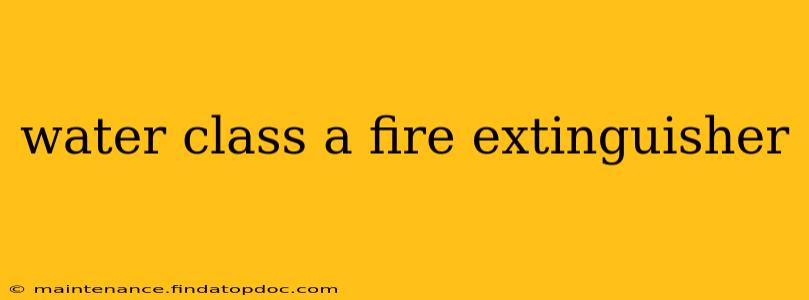Water is the most common and readily available extinguishing agent, and Class A fire extinguishers leverage its power to combat fires involving ordinary combustibles. Understanding their capabilities, limitations, and proper usage is crucial for fire safety. This comprehensive guide will cover everything you need to know about water Class A fire extinguishers, answering many frequently asked questions.
What is a Class A Fire?
A Class A fire involves ordinary combustible materials like wood, paper, cloth, rubber, and many plastics. These materials burn readily and leave behind ash. Water's effectiveness stems from its ability to cool the burning material below its ignition temperature, thereby extinguishing the fire.
How Does a Water Class A Fire Extinguisher Work?
A water Class A fire extinguisher uses pressurized water to douse the flames. The water absorbs heat, reducing the temperature of the burning material and preventing further ignition. The pressurized discharge also helps to disrupt the combustion process, effectively breaking the fire triangle (fuel, heat, oxygen).
What are the Advantages of Using a Water Class A Fire Extinguisher?
- Cost-effectiveness: Water is readily available and inexpensive, making these extinguishers a budget-friendly option.
- Simplicity: Their operation is straightforward, requiring minimal training.
- Effectiveness: Highly effective against Class A fires, particularly in their early stages.
What are the Disadvantages of Using a Water Class A Fire Extinguisher?
- Ineffective against other fire classes: Water is not suitable for Class B (flammable liquids), Class C (energized electrical equipment), or Class D (combustible metals) fires. Using water on these fires can be dangerous and even exacerbate the situation.
- Conductivity: Water conducts electricity, making it dangerous to use on electrical fires.
- Damage potential: Water can cause significant damage to property due to water damage.
- Limited range: The effective range of a water extinguisher is relatively short compared to other types.
What Types of Water Class A Fire Extinguishers are Available?
While the core function remains the same, variations exist in size, pressure mechanisms (stored pressure or cartridge-operated), and nozzle design. Larger extinguishers offer greater capacity, while the nozzle design can influence the spray pattern (jet or mist).
How to Use a Water Class A Fire Extinguisher?
Remember the PASS method:
- Pull the pin.
- Aim at the base of the fire.
- Squeeze the lever.
- Sweep from side to side.
Always maintain a safe distance from the flames and ensure there's a clear escape route.
How Often Should a Water Class A Fire Extinguisher Be Serviced?
Regular servicing is crucial for ensuring the extinguisher's effectiveness. The frequency of servicing depends on local regulations and the extinguisher's specific requirements, but annual inspections are generally recommended.
Can I Use a Water Class A Fire Extinguisher on a Grease Fire?
No. Never use a water-based extinguisher on a grease or oil fire (Class B). Water will cause the grease to splatter, spreading the fire and potentially causing serious burns.
Can I Use a Water Class A Fire Extinguisher on an Electrical Fire?
No. Water conducts electricity and can electrocute the user. Use a Class C fire extinguisher designed for electrical fires instead.
Where Should I Place a Water Class A Fire Extinguisher?
Locate extinguishers in readily accessible areas near potential fire hazards, ensuring clear visibility and easy access. Keep them away from extreme temperatures and direct sunlight.
This guide provides a foundation for understanding water Class A fire extinguishers. Remember that proper training and familiarity with fire safety procedures are paramount for effective fire prevention and response. Always prioritize safety and consult with local fire authorities or professionals for specific guidance.
